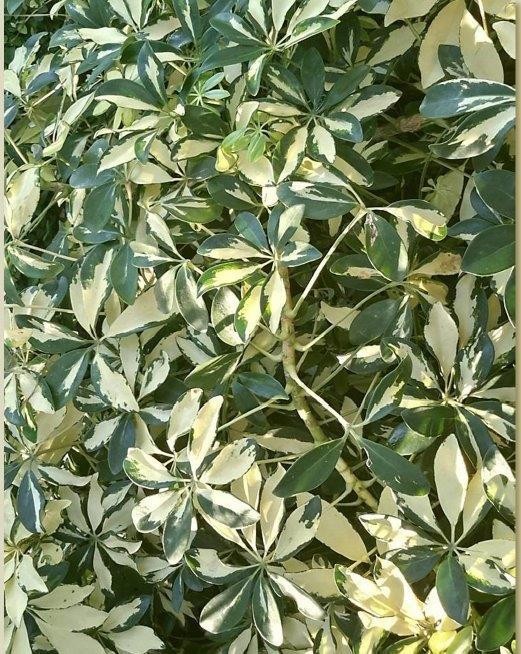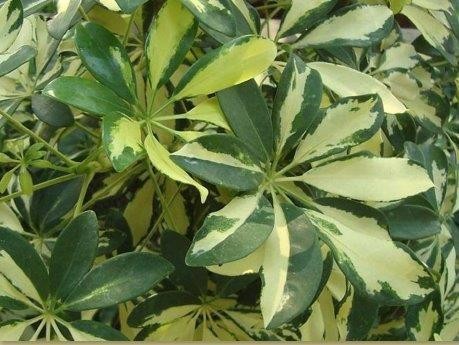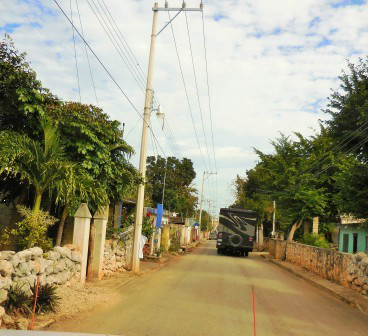By Tommy Clarkson from the December 2017 Edition
Variegated Dwarf Umbrella Tree, Schefflera arboricola ‘Variegata’
Family: Araliaceae
Also known as: Dwarf Schefflera, Hawaiian Schefflera, Umbrella Plant, Queensland Umbrella Tree, Octopus Tree or Arboricola
I acquired our initial Variegated Dwarf Umbrella Tree specimen several years ago, intending to research and write about it “right away”. That task remained unaddressed until – while searching for some large macetas (planter pots) at the vivero (nursery) of my friend Luis – I came across some plants of this species that were slightly different than those growing so well back in Ola Brisa Gardens.
Eagerly – I am sure – they fairly jumped into Sean (my faithful, nineteen year old truck) with the four large pots and three other new plants. Now – as I write – they are being happily ensconced in their new home, by our senior (or is that Señor) gardener José, near a Coffee Bush, some Bird’s Nest Ferns, Dieffenbachias and two Dwarf Fishtail Palms!
As we’ve discovered with no few other tropical plants, this, too, is sometimes known by another name – Heptapleurum Arbori-colum. But, regardless of what one calls it; this multitrunked plant comes highly recommended. No less than the well-respected botanical professional, Robert Lee Riffle, has authoritatively asserted that “There is nothing finer for adding tropical color to shady situations.” I certainly concur with him. (And, believe me, in the course of my many years traveling around the world, I’ve been in some really, shady situations!)
The Schefflera arboricola is one of more than seven hundred species in this genus coming from the tropical areas of the Americas, Asia and Australia, as well as the Pacific Islands. This particular evergreen shrub is of oriental origin, coming from Taiwan and southern China. Growing, in the right environs, it can achieve an ultimate height of eight to even twenty feet (2.44 – 6.10 meters). So, at its fullest grown capacity, is it a large bush or a tree? Remember, Gertrude Stein said “A Rose is a rose is a rose.” The choice is yours!
It likes full to partial sun and moderate watering in its well-draining “root room.” It’s not drought tolerant and requires moist, quality, friable soil (from rock that was easily crumbled

(Manihot esculenta)
and reduced to a more powder-like form) if it is to realize its full potential. As to how much agua you should give it, over-watering is more of a problem than lack of water. Just use some common garden hose sense!

It has six to ten palmately compound leaflets of four to six inches (10.16 – 15.24 cm) long. Lose no sleep if you inadvertently get it confused with the – quite similar in appearance – smaller Schefflera actinophylla. However, the plant of which we speak here is the variegated species and has irregular, cream markings on its leaflets. These – like those of the solid green ones – are leathery and oblanceolate shaped, and one and a quarter to four and a half inches (3.18 – 11.43 cm) long. There are three varieties of Variegated Dwarf Umbrella Trees: ‘Gold Capella’ has variegated yellow or gold and green leaves, ‘Trinette’ sports variegated cream and green leaves and ‘Dazzle’ is variegated with some leaves almost completely creamy-white.
Flora on the Schefflera arboricola is seldom seen in cultivation. On its own, out in its native environment, it flowers intermittently throughout the year, not simply “born on the 4th of July!” Actually, they are on terminal panicles of up to fourteen inches (35.56 cm) wide that are dense with umbels. (These are inflorescences with stalked flowers radiating from the end of the stalk in the form of an umbrella-shaped cluster of tiny yellow and orange flowers.) In turn, the fruits are small orange to black berries.
Beyond its uses as a border or accent plant, as Riffle states, “It also makes a beautiful espalier against semi-shady walls where its beautiful leaf form can be silhouetted, and there are few more beautiful large groundcovers.” (For some of us who weren’t quite – or at all – sure, an espalier is a structured means of controlling plant growth by pruning and/or tying its branches to a frame against a wall, fence, or trellis.)
The Variegated Dwarf Umbrella Tree is more sensitive to the cold than its wholly green kin. And as to feeding it, I’d suggest that you give it a bit of diluted fertilizer once a month during its growing season.
Lastly, “Let the canine or feline diners beware” as it is mildly toxic when ingested.
For back issues of “Roots”, gardening tips, tropical plant book reviews and videos of numerous, highly unique eco/adventure/nature tours, as well as memorable “Ultimate Experiences” such as Tropical Garden Brunches
Visit us at… www.olabrisagardens.com
Download the full edition or view it online
—
Tommy Clarkson is a bit of a renaissance man. He’s lived and worked in locales as disparate as the 1.2 square mile island of Kwajalein to war-torn Iraq, from aboard he and Patty’s boat berthed out of Sea Bright, NJ to Thailand, Germany, Hawaii and Viet Nam; He’s taught classes and courses on creative writing and mass communications from the elementary grades to graduate level; He’s spoken to a wide array of meetings, conferences and assemblages on topics as varied as Buddhism, strategic marketing and tropical plants; In the latter category he and Patty’s recently book, “The Civilized Jungle” – written for the lay gardener – has been heralded as “the best tropical plant book in the last ten years”; And, according to Trip Advisor, their spectacular tropical creation – Ola Brisa Gardens – is the “Number One Tour destination in Manzanillo”.


